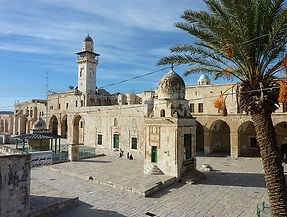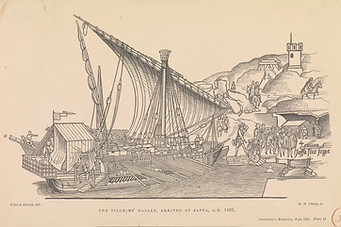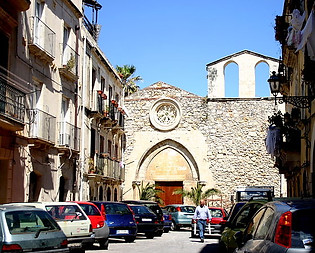
1260 AD
1291 AD
1517 AD

Mamluk Madrassa King Faisal - Jeruzalem
MAMLUKS BEZET ISRA .L
1292 AD - 1517 AD

De Mamluk Sultanaat was middeleeuws rijk verspreid over Egypte, de Levant en Hejaz en vestigde zich als een kalifaat. Het duurde van de omverwerping van de Ayyubid-dynastie tot de Ottoma-verovering van Egypte in 1517. Historici hebben het tijdperk van de Mamluk-heerschappij van oudsher in twee perioden verdeeld, een die 1250-1382 (de "Bahri" -periode) en de andere 1382-1517 (de "Burji" -periode), genoemd naar de heersende dynastieën van de respectieve tijdperken. Moderne bronnen verwijzen ook naar dezelfde indelingen als de ; Turks;' en 'Circassiaanse' perioden om de verandering in de etnische afkomst van de meeste Mamelukken te benadrukken. Een van de belangrijkste gebeurtenissen in deze periode vond plaats toen 1250 AD de Mamluk Kalief ontmantelt de muren van Jeruzalem. Met deze bescherming verdwenen, de bevolking van Jeruzalem snel daalt.
(Foto hierboven: Mamluk Madrassa King Faisal, Wikimedia commons)
CONQUEST OF AKKO/ACRE

The Mamluks regarded what is now Israel as part of Syria. One of the major events during this period happened when in 1250 AD the Mamluk Caliph dismantles the walls of Jerusalem. With this protection gone, the population of Jerusalem rapidly declines. Akko, the last stronghold of the crusaders was taken in 1291 by the Al-Ashraf Khalil, the eight "Bahri" Mamluk Sultan (Turkic origin). Many of the citizens (Christians and Jews) were killed during this Siege of Akko and the Jews that survived fled. The Jewish Kabbalist, Isaac ben Samuel of Acre was in town of Akko and was arrested and thrown into prison with many other Jews. Fortunately he escaped the massacre and he fled to Spain. He was a pupil of Rabbi Nahmanides and he wrote several Hebrew books of which 'Meirat Enayim' survived in later 15/16th century copies. The Mamluks made the 'strategic decision' to destroy the coastal area and as a consequence bring desolation to many of its coastal cities. Ports were destroyed and various materials were dumped to make them inoperable. The goal was to prevent attacks from the sea, given the fear of the return of the Crusaders. This had a long-term effect on those areas, which remained sparsely populated for centuries. The Jewish community in Akko shifted inlands and Safed, Jerusalem and the Galilee became the most important communities in the 13th and 14th century.
Mamluk Minaret - Yavne. Photo:Dr. Avishai Teicher
MAMLUK RULE OF THE HOLY LAND
Under Mameluke rule, the region of the holy land was divided into six city-based districts (Ramla, Nablus, Hebron, Safed, Gaza and Jerusalem) within the larger province of 'Bilad al-Sham' or Islamic Syria that was centered in Damascus. The term "Palestine or Filastin" was no longer officialy used, having become a largely obsolete Roman-era designation.
The Mamluks were often intolerant and harrassed the local Jewish and Christian populations. Often hatred and violence was aimed at the larger Christian population especially in Egypt. Amidst conflicts, pilgrims persisted in small numbers, and Pope Nicholas IV brokered an accord with the Mamluk sultan, allowing Latin clergy to officiate in the Church of the Holy Sepulchre. Pope Nicholas, a Franciscan himself, dispatched friars to sustain the Latin liturgy in the Church of the Holy Sepulchre in Jerusalem. Robert of Sicily who was a central figure of Italian politics of his time was helpful for the Christians in the holy land. This Robert of Anjou was King of Naples and Sicily and also held the title King of Jerusalem. In 1300, King Robert of Sicily's gave a generous gift to the Sultan in Damascus and he secured the Sion Church, the Mary Chapel in the Holy Sepulchre, and the Nativity Cave in Bethlehem for the Franciscans. However it still remained prohibited to restore all the other Christian holy places.
The continual diplomatic efforts of the kings of Aragon and Naples eventually resulted in the founding of a Franciscan settlement in Jerusalem in 1335 that continues until today.

The Mamluk sultans revitalised Jerusalem by promoting Muslim settlement and the constructing or expanding of mosques. The Mamluks were often intolerant and harrassed the local Jewish population. Jews did not have full religious rights and were banned from Temple mount. In Hebron, the Mamluk ruler Baibars, had banned Jews from worshipping at the Cave of the Patriarchs (the second-holiest site in Judaism). Jews were only allowed to enter 7 steps inside the site. In contrast to this hatred the Sultan later renewed the Muslim alliance with the Jews and Baibers established two new sanctuaries, one to Moses near Jericho and one to Salih near Ramla. The Sultan wished to encourage many Muslim and Jewish pilgrims to be in the area at the same time as the Christians, who filled the city during Easter. Also in 1267 Nahmanides (also known as Ramban) made aliyah. In the Old City he was able to establish the Ramban Synagogue. This synagogue together with the Karaite synagogue are the oldest still active synagogues in Jerusalem. Jerusalem however had no great political power and the city itself was ruled by a low-ranking emir.

%20fountain%20qayt%20bayt.jpg)
The 'Fountain (sabil) of Qayr Bay' built in 1455 by sultan Sayf ad-Din Inal. Photo by DYKT Mohigan
JEWISH LIVE DURING MAMLUK PERIOD
Jerusalem 1450 AD
Despite the difficulties and heavy taxes that existed for Dhimmi's immigration to Eretz Yisrael continued and during the 14th century Jerusalem became once again a central meeting place for both the Sephardic, Ashkenazi and Oriental Jewish communities. Spanish Jews, Jewish intellectuals from Muslim countries and Ashkenazi scholars from the Rhineland community arrived in Jerusalem. This migration was driven by anti Jewish violence in Spain in 1392, expulsions in German cities and the Fall of the the Byzantine Empire after the Ottomans conquered Constantinople. These events made many Jews think the end of Christianity was near. Isaac HaLevi Asir HaTikvah also known as Isaac of Beilstein, was an important 14th-century Ashkenazi Rabbinic leader. He immigrated to Jerusalem in 1350 AD with a group of students and founded a yeshiva in Jerusalem with financial help from Jewish communities in Europe. Many other devoted Jews followed their religious obligation travelling and 'ascending' to the Holy land. Many where part of the religious elite in their communities in Europe or the Middle East but when they arrived the often were encountered hostility from local leaders (parnasim) that where afraid to lose their authority. Officially the leader of the Jews in the Mamluk state was the Nagid, or 'Prince' from Cairo. He was both the leader Egypt, Syria and the region of Palestine and had a deputy leader in Damascus and in Jerusalem in the 14th century. During the 14th century cultural live in Jerusalem was growing and many important Jewish manuscripts were written in Jerusalem on Halakhah (Jewish law), mysticism and philosophy.

Beautiful Mamluk architecture in Jerusalem. Photo: Yoav Dothan
Bedevaart & heilige plaatsen
In de 15e eeuw Obadiah ben Abraham van Bertinoro telde 70 Joodse families in Jeruzalem. Hij was een Italiaanse rabbijn die van 1485 door de Middellandse Zee en Egypte reisde tot hij in 1488 Jeruzalem bereikte. Hij was vooral bekend om zijn populaire commentaar op de Misjna, algemeen bekend als "De Bartenura". Als gevolg van de verdrijving van de Joden uit Spanje in 1492, vestigden veel van de ballingen zich in Jeruzalem en Rabbi Bertinoro werd hun intellectuele leider die de Joodse gemeenschap van Jeruzalem verjongde. Deze Spaanse Joden boden Bertinoro een site aan voor een yeshivah in Jeruzalem, dat hij stichtte. Hij werd in 1515 begraven op de Joodse begraafplaats op de Olijfberg in Jeruzalem.
Bartenura Mishna commentaar
Tijdens de 14e eeuw ging de bedevaart naar Israël door en het verslag van Isaac ben Joseph ibn Chelo (zie 'Pelgrims naar het heilige land' door Moshe Pearlman) is waardevol. Isaac ben Joseph stelt in 1334 na Christus dat de heilige plaatsen zoals Hebron (graven van de aartsvaders) en de Tempelberg waren verboden voor Joden om te betreden, maar ook dat Joden talrijk waren in zowel de steden Hebron als Jeruzalem. Ze werkten in winkels, handelsactiviteiten, verschillende ambachten en wetenschap (zoals medicijnen, astronomie en wiskunde). En hij noemde veel Joden die Thora, Talmoed en kabbalistische mystiek bestudeerden en baden aan de Wachterste muur van de Tempelberg.

Pilgrims arriving in Jaffa in 1483. Bernhard von Breidenbach

Franciscaans symbool op via Dolorosa - Jerusalem
Foto: Deror Avi
CHRISTIAN PILGRIMS
Tijdens de Mamluk-periode was christelijke bedevaart gebruikelijk en gebeurde op grote schaal. Jaarlijks bezochten vele duizenden pelgrims Israël en de Franciscanen, aangezien de bewaarders van de heilige plaatsen een cruciale rol speelden in dit fascinerende fenomeen. De Franciscanen zorgden niet alleen voor de kerken en heilige plaatsen, maar boden ook eten en onderdak aan tijdens de pelgrimsreizen. Josephie Brefeld analyseerde vele beschrijvingen van de reizen van pelgrims in 5 talen (Latijn, Frans, Engels, Duits en Nederlands) en vond sterke steun voor de suggestie in 1880 dat de pelgrims tijdens hun reizen een reisgids gebruikten. In haar boek 'Een gids voor de pelgrimstocht naar Jeruzalem in de middeleeuwen' (1994) laat ze zien dat, ongeacht de taal, de meeste verslagen een opvallende parallel vertonen: de heilige plaatsen worden in een vaste volgorde en in vrijwel dezelfde woorden vermeld. Mogelijk is deze gids gebruikt of geschreven door dezelfde Franciscanen. Hoewel de meeste pelgrims mannen waren, zijn er enkele verhalen die melding maken van vrouwen die naar het heilige land reizen. Het verhaal van Margery Kempe die pelgrimstochten maakte in Europa en naar Israël is erg interessant. Ze verliet Engeland toen haar vader in 1415 was overleden en ze reisde naar het heilige land, bezocht vele heilige plaatsen voordat ze in 1417 naar huis terugkeerde.
STRUGGLE & BARRIERS
Even during periods when Jewish life was expanding in the Land of Israel, and significant contributions from the Diaspora supported the revival of its communities, this does not represent the full historical picture. During the Mamluk period (1250–1517), Jewish migration to the Land of Israel was extremely difficult due to a combination of external Christian restrictions and internal Islamic policies. European rulers actively suppressed organized aliyah attempts, while the Mamluk authorities imposed heavy taxation and severe legal restrictions on non-Muslim subjects (dhimmis) and offering them few rights or protections.
-
In 1286, Rabbi Meir of Rothenburg attempted to lead a group of Jews from Germany to settle in Palestine, but was imprisoned by Emperor Rudolf I. Though this took place under Christian rule, it reflects the broader European hostility that discouraged Jewish migration.
-
Later, in 1428, when German Jews tried to purchase rooms on Mount Zion, Franciscan monks petitioned Pope Martin V, resulting in a papal ban forbidding sea captains from transporting Jews to Palestine, cutting off a vital migration route.
-
In 1455, decades before the Expulsion of all Jews by the Spanish Empire, Jews in Sicily sought permission to migrate to the Land of Israel. As royal property (Servi camerae regis), their request was denied. They were arrested, threatened with enslavement, and released only after paying a massive ransom of 1,000 ounces of gold. Similar stories occurred elsewhere: despite destruction and exile, Jews longed for Zion and clung to the hope of return. Each failed aliyah attempt, especially when violently suppressed, sent shockwaves through the Jewish world, discouraging others from trying.

Franciscaans symbool op via Dolorosa - Jerusalem
Foto: Deror Avi
WOMEN PILGRIMAGE TO THE HOLY LAND
.jpeg)
St. Brigitta in a painting from 1476. (wikimedi acommons).
According to a growing group of scholars, women were active as pilgrims in the Middle Ages. Associate professor at Ohio University, Leigh Ann Craig, states there is enough evidence for the presence of female pilgrims during pilgrimages to the Holy Land but there is lack of research on this important topic: ‘many scholars of pilgrimage have simply noted women’s presence on such journeys without fully examining their experiences.’
The experiences of women pilgrims can be examined by looking at accounts of pilgrims that mentions female pilgrims. The story of Margery Kempe who made pilgrimages in Europe and to Israel is a very interesting example. She was married woman and became famous for her pilgrimages and her meeting with some of the greatest medieval religious figures on her long journeys. She became a devoted christian and a female mystic. She wrote about her experiences in "The Book" that was not written by Margery herself, since she was illiterate, but dictated by her. Her book is the oldest example of an autobiography in the English language. Margery left England when her father had died in 1415 and she travelled to the holy land, visited many sacred sites before she returned home in 1417. (see link)
Margery of Kempe and her pilgrimage were not unique but she was one of several notable female mystics. Another well known example in the late medieval period is Saint Birgitta of Sweden, a noblewoman who dedicated her life to becoming a visionary and pilgrim following the death of her husband. She made pilgrimages to Rome, Jerusalem and Bethlehem and was later canonised as a saint.

Jethro's Tombeeen heilige plaats voor de Druzengemeenschap in Israël. Foto: Saleh Aqel Khatib

Druzen religie in Israël
De Druzen-religie die in Egypte begon, werd een kleine minderheidsreligie in Israël. De Druzen die zichzelf al-Muwaḥḥidīn noemen (wat "de Monotheïsten" betekent) zijn een esoterische, monotheïstische religieuze gemeenschap die nog steeds te vinden is in Syrië, Libanon, Jordanië en het noorden van Israël. Ook al ontwikkelde het geloof zich oorspronkelijk in Egypte uit Ismaili Islam, identificeren de meeste Druzen zich niet als moslims en accepteren ze de nietvijf zuilen van de islam. De Druzen hebben vaak te maken gehad met vervolging door verschillende moslimregimes en ook door het Ottomaanse rijk. Deze vervolging van de Druzen omvatte bloedbaden, vernietiging van heilige plaatsen en gedwongen bekeringen tot de islam en volgens de Druzengemeenschap was deze vervolging bedoeld om de hele gemeenschap en religie uit te roeien. Een van de belangrijkste Druzen geschriften the Brieven van Wijsheid bevat antisemitische teksten. Een brief beschrijft dat de grondleggers van het Druzisme, Baha al-Din al-Muqtana, beschuldigt Joden van het doden van de heilige profeten en een dergelijke tekst zou de voortdurende spanningen tussen de Joden en de Druzengemeenschappen kunnen hebben veroorzaakt. Benjamin van Tudela, beschrijft echter dat de Druzen goede handelsrelaties onderhielden met de Joden in de buurt, en volgens hem was dit omdat de Druzen van het Joodse volk hielden. De meeste Joden en Druzen leefden geïsoleerd in hun eigen dorpen, behalve in enkele gemengde steden zoals Deir al-Qamar (Libanon) en Peki'in (Israël). Het is duidelijk dat er in Israël tijden waren van vreedzaam samenleven tussen Joden en Druzengemeenschappen. Maar ook de Druzenaanval op de Joden in Safed in 1838 zal herinnerd worden in de lange geschiedenis van de Joods-Druzenrelatie.
.jpeg)
















%20Godot13.jpg)

_heic.png)
